Middleweight Naked Bikes: A 2017 Shootout!
Benelli TnT600 vs. Harley-Davidson Street Rod vs. Kawasaki Z650 vs. Suzuki SV650 vs. Yamaha FZ-07
Three years ago in its maiden season, the Yamaha FZ-07 came out with both 80mm pistons blazing to take the win from five other tasty middleweights (including the KTM 690 Duke) in our 2014 Middleweight Mash-Up Six-Way Shootout! Last year, we threw the Yamaha in with the Duke 690 again – also the reborn Suzuki SV650 (alongside Gabe’s old SV, because why not?), and watched as the Yamaha lost out to the Duke by the slimmest of margins (a different set of testers…), on its way to beating up (barely) the new Suzuki SV.
This year, we decided to leave the KTM out of it, #1 because we didn’t have one, and #2 because we had a couple of other new players closer to the design brief to subject to the FZ-07/ SV650 litmus test: Harley’s new Street Rod, the new Kawasaki Z650 and the Benelli TnT 600. The fact that these new players exist tells us affordable, fun, practical middleweights is a an important category for the manufacturers. Not to mention being some of our absolute favorite every-day motorcycles to tear around upon (though we did get sidetracked and over-stimulated there for a few weeks by our Superbike comparison).
As a matter of fact, the Suzuki was the first to try to horn in on a little of the action Ducati stirred up with its first Monster, which sort of created this class of bike in the modern era. We nearly included Ducati’s latest Monster here – the 797 – but decided against it since that bike sells for a hefty premium compared to the rest of these and has a bit more motor, at 796cc.
JB First Ride Review: Ducati Monster 797
Without further ado, may we have the envelope please. It’s LaLa Land! Not really.
Benelli TnT600
It really is too bad about the TnT, because there really is a lot to like. These are stamped out by Qianjiang in China, but design was by Benelli’s people in Italy. The undertail exhausts give away the fact that the design’s about a decade old now (though only recently offered in the USA), but the whole package has aged well. There’s a genuine steel-trellis frame tying the cast aluminum lower frame plates and swingarm and inverted 50mm fork together, along with their full-size wheels and tires. Overkill 320mm discs squeezed by Benelli-branded four-piston knock-off Brembo calipers give this one great stopping power when you give the lever a big squeeze.
Matter of fact, the whole bike is overkill: The 50mm fork sliders, for example, are clamped in triple trees that may have just been handed down from the 1130 TnT Triple of yore, and the whole plot, full of 4 gallons of gas, winds up tipping yon scales at 512 pounds – which makes it 123 pounds heavier than the lightest bike here, the Kawasaki Z650. That’s not light, but then this is the only bike here packing a 599cc DOHC inline four-cylinder, which should make enough power to mask that weight. In theory.
The Benelli’s wants to be more Grand Tourer than out-and-out sportbike, and in that role, it does pretty well. It has a firm-enough ride that’s always compliant, its cantilevered rebound-adjustable shock there on the right does nice work. The seat’s comfortable enough, the tapered aluminum handlebar puts the handles in the right spots, engine vibes are under control – and the overall fit and finish is so nice that, right until you ride away, you’d never think you weren’t about to be in for a treat on a perfectly nice exotic European motorcycle.
The claim is 82 horsepower, which would be semi-respectable for a torquey, mid-rangey four-banger. Unfortunately the Benelli’s engine only gets to 70.4 hp on a rear-wheel dyno, and not until 11,300 rpm. And at no point is its torque output anything resembling respectable: Max torque is a limp handshake 34.4 lb-ft, and you don’t even get that till 10,200 rpm. The torque king of the group, the Yamaha FZ-07, for comparison, is cranking out 46.6 lb-ft at 6500 rpm. Trying to hang with the other kids in the curvery stuff, the TnT builds revs painfully slowly till the tach approaches 7,000. Then, when you roll out of the “power” for an approaching curve, what feels like a really heavy crank just wants to keep spinning, providing very little engine braking.
If you hop on the Benelli and ride it like you stole it, i.e., keeping the tach between 7 and 11,000 rpm the whole time, it’s fairly spunky and fun to ride. But constantly revving it out grows old in a hurry when you’re commuting, and it’s not made any easier that the bike changes gears in an old-fashioned way: Clutch pull is not light, and shift lever throws feel long and sloppy after climbing off the other bikes here, because they are.
As for the shifting, you could get used to it and build character. As for the engine, we can’t help thinking there’s a great motor in there yearning to breathe free via the right engine map, but the TnT is such a small-batch item in the U.S., we can’t find anything to make it right. The Benelli seems so close to being a great little exotic bike, but as delivered, it’s so far away… about one ECU away.
“Most of the TnT’s flaws could be forgiven if not for the flaccid engine that spoils the rest of the experience,” observes EiC Duke.
What’s the Thai Long Ly verdict?
Beautiful bike. Love the MV-esque tank and the dated high pipes. Like a sexy Italian model, this bike looks great from every angle. Unfortunately, the engine has the pull of 7, perhaps 8 Alpine Marmots, offering all the excitement of jury duty. The bike sounds fast, with an intoxicating wail and whine worthy of a MotoAmerica paddock, but the absolutely anemic inline-Four packs the punch of an anorexic coke whore.
Harley-Davidson Street Rod
Hey, the Street Rod won the “Cool Factor” on our Scorecard with a solid 88.5% – fully six points more than the Kawi Z650 in second place.
“It draws a lot of attention,” says Tamara, “I received more than a half-dozen unsolicited comments from other motorists and pedestrians at lights, gas stops, etc., on a short 50-mile test ride.” Tamara is six-feet tall with long red hair and wearing leather pants. But the rest of us experienced the same thing.
“It’s one of the most exciting Harleys I’ve ridden,” Duke raves, “with a rompin’ motor and undeniable curb appeal.” Nine out of 10 bystanders agree.
Speaking of romping, she also did well in the engine department, nipping at the heels of the SV and FZ-07 in the tester’s subjective rankings. The biggest engine in the test (750cc) didn’t make more torque than those two, but the `Rod does crank out its comparable 45 lb-ft at only 4100 rpm, which gives it a really broad, Harley-esque powerband. Less Harley-esque is that it revs on out to 8800 rpm and 63 horses. It’s a really fun motor that reminds some of us of the 90-degree Twin in the Suzuki (which squeezed 72 horses from its 645cc).
“It’s actually quite nimble through the canyons,” noted Thai Long Ly after it acquitted itself on the mountain course. “I was surprised at its ability to stay with the pack of smaller, more nimble bikes as the day wore on. It’s not a bike you immediately climb on and haul ass with. It takes some time to unlock.”
With a wheelbase three or four inches longer than the Japanese entries, and carrying a bunch more weight, the H-D still turns and burns surprisingly well, with the least trail of any of these at just 3.7 inches and nicely balanced suspension at both ends. It’s even got okay ground clearance, though it will start dragging its peg feelers before the other bikes.
“The engine has a great sound and a romping personality”, says Evans. “Handling is okay. Braking is decent. This really could be a great bike.”
| Observed MPG | |
| Benelli TnT600 | 43 mpg |
| Harley-Davidson Street Rod | 42 mpg |
| Kawasaki Z650 | 44 mpg |
| Suzuki SV650 | 48 mpg |
| Yamaha FZ-07 | 47 mpg |
That sums up how we all felt about the Street Rod: It could be a great bike and we all wanted it to be. But it’s not, and it’s all down to the abysmal ergonomics enforced by H-D’s insistence on using the same exhaust system as the Street 750. Arranging mid-mount footpegs around that system results in too little legroom for even short riders and awkward airport men’s room wide-stance Senatorial foot positioning for everybody. The people have spoken:
Tamara: Immediate discomfort in your hip flexors. The aggressive riding position feels to be signatory to H-D attitude but impairs performance when you can’t feel your legs after a few commuter miles.
Brasfield, Evans: The riding position is an atrocity. Having my lower body in such an awkward configuration ruins what could be a really fun motorcycle.
Thai: The “Rat Fink” riding position is only appreciated by yoga masters, pilates champions and dominatrixes. Pick a safe word and thumb the starter. The semi-forward controls combined with the super-wide flat bar will have your hip flexors cringing.”
Whoever’s first to build some kind of comfort kit for this thing will probably make a small fortune. There seems to be room under the engine for a muffler (maybe give Erik Buell a call about that), and then you’d be able to put the footpegs in a position that takes the human body into account. In fact, why am I not working on assembling such a kit right now instead of typing this?
The Hog’s also the most expensive bike here, starting at $8,699 for shiny black, but you can run the bottom line up there quickly if you want our silver bike ($8,994), and ABS is a $750 option.
Suzuki SV650
Revitalized and renamed back to SV650 for the 2017 model year, the SV remains a crowd favorite, partly because of its illustrious history, partly because it’s the closest thing you can get to a Ducati Monster without buying a Ducati. Even though it was disguised for a number of years behind aliases like Gladius and SFV, it remains as familiar as your mom’s old Army boots. Matter of fact, it won the Ergonomics/Comfort category on our Scorecard, along with Clutch/Transmission. There’s also high praise for its suspension, a category it lost by a mere 0.5% to the 2nd-place finisher.
That 90-degree V-Twin produces the most horsepower, cranking out nearly 72 horses, and 45 pounding feet of torque is right there in the ballpark too. Carrying a few extra ell-bees compared to its newer Japanese rivals, riding on a longer wheelbase than any bike but the Harley, and with more trail than any of them (4.1 inches), the SV feeds back a sense of reassuring, stable handling to everyone who rides it, and still steers quick enough.
“The SV felt the most planted when leaned over,” according to Evans and other testers. “I attribute that to the well-sorted suspension. Turning requires a little more effort than either the Z or the FZ, but it never feels heavy. The SV just prefers a firm hand.”
On Tamara’s scorecard, the SV came out on top:
“Great ergonomics, especially for a 6-foot rider. Decent pull and bottom-end torque. Tight handling. Smooth power delivery with non-twitchy EFI.”
EiC Duke awarded the SV his personal favorite:
“The SV650 again impresses for its ability to feel like a mid-displacement Ducati Monster, despite its relatively inexpensive cost. The sound from its 90-degree V-Twin can fool the ears of Italian cognoscenti, and its trellis chassis feels the most composed and secure in this group. Stable and surefooted, best for racetrack, love the motor. In terms of appearance, the Suzuki hits my eyes best for its nicer-flowing lines and classic stance.”
Personally I’m with Thai Long Ly, who says, “The fit and finish aren’t exactly jeweler’s quality – it feels a bit budget.”
For me, the SV’s a perfectly okay bike that reminds me of the cost cutting Suzuki did by getting rid of the original bike’s OVER Racing-inspired oval-section aluminum frame. It reminds me of wanting those first blue suede Adidas but only being able to afford the Kinney’s knock-offs. You could take off the silver Ss on the tank and put on desmo ones, and most people would never know. But you would know.
And the runner-up is … Kawasaki Z650
That parallel-Twin isn’t close to all-new, but the bike Kawasaki built around it is. If imitation is the sincerest form of flattery, then it looks like Kawasaki was a big enough fan of the Yamaha FZ-07 to replicate it right down to its semi-trellis steel tube frame with MotoGP-style “controlled flex” ears that reach down to carry the front engine mounts, and banana swingarm.
Our man Troy Siahaan liked it a lot upon first setting cheek to Z last November, and our test crew all seemed to agree. If it’s a sporty bike for attacking backroads you’re after, the second lightest bike in the test, at 412 pounds complete with ABS, is hard to argue with – especially since it won the Handling and Suspension categories on our Scorecard.
Thai Long Ly ranked the Z number one:
“Was it the comfortable position or the excellent motor? Perhaps it was the planted suspension and the solid brakes? Whatever is was, it was my favorite bike here. It just did everything well and I was left searching for negatives. Of which I have none. Dancing through the canyons all day, she was composed and smooth. I could ram it into a corner at any speed and she kept calm and collected. This bike reaffirmed my belief that you don’t always need 175 hp and 90 lb-ft to enjoy biking.”
Tamara liked “the light, easy handling and easy clutch. Certainly no fear of arm pump for female riders. The suspension is dialed, and the seat is comfy and ergonomic.”
Brasfield says he “could really flip a coin between it and the FZ-07 and be completely happy with either one.”
EiC Duke says: “You’d be disappointed in the Z’s power only if you looked at the dyno chart. In normal use and even at elevated speeds, the Kawi’s midrange stonk feels as strong as any bike in this group. It’s got better suspension than the FZ, with greater control, and its brake feel is the most confidence-inspiring of this group. It also has a contemporary and fresh appearance, with its green trellis frame an arresting highlight on its future-forward visage.”
If you did check the dyno chart, though, you’d see that Kawasaki’s 649cc parallel Twin lags quite a bit behind the others; it’s 10 horses down on the SV and 8 behind the FZ-07. You can also feel it trying harder than the other bikes.
The price it pays for being lightest is that a bit more engine vibration finds its way up into the grips and pegs. Duke notes, it “buzzes hard around 7-8000 rpm; otherwise vibes are not an issue for me, as cruising rpm is below this annoying zone.” Brasfield says “the Z650 has more high-rpm vibration than the other bikes, but it never becomes annoying.”
Why do I always have to be the heavy? Riding home on the freeway at my usual 80-ish mph pace after our day in the mountains, I detected noticeably more vibes through the handlebar, pegs and tank than the other bikes. The Z’s light skinniness makes it a perfect lane-splitter, but that slight buzziness renders it a bit less pleasant of a carpool buddy commuter compared to the SV and the FZ.
On the official MO Scorecard, the Z also took the win in the Quality/Fit and Finish category, and it was runner-up to the Harley in Cool Factor. Its “Pearl Flat Stardust White” paint is pretty striking against the green frame and helps you overlook areas occupied by more mundane components, like the old switchgear from Japanese bikes of yore. In short, it’s a personable little motorcycle everybody instinctively likes to be around and enjoys flogging (just like the Versys 650). In the Engine category on our Scorecard, however, the Z manages to beat only the Benelli. And so it could not win this thing.
The winnah and STILL the middleweight champ! Yamaha FZ-07
It doesn’t make more peak horsepower than the Suzuki, but the FZ does use its 40 extra cc to bust out just a bit more torque in the critical 6-8000-rpm range, which makes it more thrilling to ride in the hands of experienced riders.
The ladies are supposed to like the bad boy, but Tamara sort of didn’t. Actually she did like the FZ, ranking it second just 0.6% behind the SV, but she sensed its extra power: “It definitely let’s you know you’re in gear, throws you back into the seat with each shift, with enough potential to get a new rider in trouble in the twisties.”
Anyway, the FZ engine carried the win on the Scorecard, along with its Brakes (which are four-pot calipers), even though Duke said they feel “a bit wooden.”
The Yamaha took its lumps in the Handling and Suspension categories, where it tied for second and finished third, respectively. With the least trail, shortest wheelbase, and its light weight, Duke describes it as “incredibly agile… edging toward flighty when the throttle is hammered.”
Now we light the Thai comment and stand clear:
“The front end feels floppy and light as a nun’s nipple. Though she steers quickly, she doesn’t exactly inspire any confidence when pushed against an apex. The mechanical grip is there, you just have to trust it. This bike is all about the motor. The engine spins up quickly and is super playful. The midrange is strong and the bike pulls creamily to redline.”
(It’s interesting how differently people perceive vibrations. Thai says the FZ is smoothest, Tamara notes “some buzz at around 7000 rpm in 2nd and 3rd gear,” and Evans says “buzziest of the bunch, but it never crosses over into annoying. Where the Z650’s vibes increase at higher rpm, the FZ’s remain mostly the same, making it easier to overlook.”
Evans Brasfield (who’s a bit heavier than Thai and Duke and loads the suspension a bit more) says:
The FZ makes me feel like I’m riding right over the front wheel. It’s steering response is immediate and precise. I feel like a hero after a series of corners (and I need all the help I can get). While the suspension does get a little boingy at times, the underdamped nature never interferes with being able to make good time on a windy road.
The Yamaha scored second in Comfort/Ergonomics (behind the Suzuki), second in Quality/Fit and Finish (behind the Kawasaki). And however many nits were picked, and despite the fact that two testers ranked the SV650 number One, and one tester put the Z650 on top – the FZ still emerged a clear winner. Perhaps most importantly, the FZ outpointed the others by a massive 2.5% gap in the all-important Grin Factor category.
Seems like another clear-cut, if close, win for one of our favorite motorcycles of the decade, and a win also for everybody who likes more choices in one of our favorite categories; the Z650 and SV650 are this close if the FZ-07 just doesn’t do it for you.
Normally we’d say there are no bad choices here, but there are two of them. And all they need is a little love. You can’t go wrong.
2017 Middleweight Naked Shootout Scorecard | |||||
|---|---|---|---|---|---|
Benelli TnT600 | Harley-Davidson Street Rod | Kawasaki Z650 | Suzuki SV650 | Yamaha FZ-07 | |
Price | 100% | 80.5% | 94.6% | 93.3% | 93.3% |
Weight | 76.0% | 74.0% | 97.82% | 88.4% | 100% |
lb/hp | 80.8% | 70.2% | 92.2% | 95.2% | 100.0% |
lb/lb-ft | 57.7% | 72.9% | 96.6% | 88.7% | 100.0% |
Total Objective Scores | 81.0% | 75.3% | 96.3% | 91.1% | 96.7% |
Engine | 53.5% | 89.5% | 87.0% | 90.0% | 92.8% |
Transmission/Clutch | 59.0% | 72.0% | 81.0% | 85.0% | 84.0% |
Handling | 76.0% | 75.5% | 89.5% | 86.5% | 86.5% |
Brakes | 81.0% | 79.0% | 85.0% | 85.0% | 85.5% |
Suspension | 81.0% | 79.9% | 85.0% | 84.5% | 82.5% |
Technologies | 69.0% | 70.0% | 79.0% | 77.5% | 79.5% |
Instruments | 72.5% | 72.5% | 78.0% | 77.0% | 80.0% |
Ergonomics/Comfort | 76.0% | 52.0% | 81.0% | 83.5% | 82.5% |
76.5% | 76.0% | 82.5% | 79.0% | 81.5% | |
Cool Factor | 80.0% | 88.5% | 82.5% | 81.0% | 81.5% |
Grin Factor | 53.0% | 73.0% | 81.0% | 81.5% | 84.0% |
Kevin’s Subjective Scores | 69.6% | 74.2% | 85.4% | 86.0% | 84.4% |
Tamara’s Subjective Scores | 65.8% | 76.7% | 81.7% | 84.0% | 83.3% |
Thai’s Subjective Scores | 71.5% | 79.0% | 82.5% | 80.8% | 80.6% |
Evans’ Subjective Scores | 69.0% | 75.2% | 85.6% | 84.6% | 86.5% |
John’s Subjective Scores | 70.4% | 76.9% | 80.8% | 81.5% | 87.3% |
Overall Score | 69.3% | 76.4% | 83.0% | 82.2% | 84.4% |
2017 Middleweight Naked Shootout Specifications | |||||
|---|---|---|---|---|---|
| Benelli TnT600 | Harley-Davidson Street Rod | Kawasaki Z650 | Suzuki SV650 | Yamaha FZ-07 | |
| MSRP | $6,999 | $8,699 | $6,999.00 $7,399 w/ABS | $6,999 $7,499 w/ABS | $7,199 $7,499 w/ABS |
| Engine Type | 599cc Inline-Four, liquid-cooled, EFI, DOHC, four-valves per cylinder | 750 cc, 60-degree liquid-cooled V-Twin, EFI, SOHC, 4 valves per cylinder | 649cc Parallel-Twin, liquid-cooled, EFI, DOHC, four-valve | 645cc V-Twin, liquid-cooled, EFI, DOHC, 4 valves per cylinder | 689cc, parallel-Twin, liquid-cooled, EFI, DOHC, 4 valves per cylinder |
| Bore and Stroke | 65.0mm x 45.2mm | 86.0mm x 66.0mm | 83.0mm x 60.0mm | 81.0mm x 62.6mm | 80.0mm x 68.6mm |
| Compression Ratio | 11.5:1 | 12.0:1 | 10.8:1 | 11.2:1 | 11.5:1 |
| Rear Wheel Horsepower | 71.4 @ 11,300 rpm | 62.87 @ 8800 rpm | 60.95 @ 8000 rpm | 71.6 hp @ 8700 rpm | 68.2 hp @ 8900 rpm |
| Torque | 34.4 lb-ft @ 10,200 rpm | 44.68 @ 4100 rpm | 43.71 lb-ft @ 6700 rpm | 45.4 lb-ft @8000 rpm | 46.6 lb-ft @ 6500 rpm |
| Transmission | 6-speed | 6-speed | 6-speed | 6-speed | 6-speed |
| Final Drive | Chain | Chain | Chain | Chain | Chain |
| Front Suspension | 50mm inverted fork, non-adjustable; 4.7 inches travel | 43mm inverted fork, no adjustment; 5.2 in. travel | TKmm telescopic fork, non-adjustable; 4.9 inches travel | 41mm telescopic fork; TK inches travel | 41mm telescopic fork; 5.1 in. travel |
| Rear Suspension | Single shock, adjustable for preload and rebound; 4.8 inches travel | Dual piggyback shocks; preload adjustable, 4.6 in. travel | Horizontal single shock, adjustable for preload; 5.1 inches travel | Single shock, preload adjustable; TK inches travel | Single preload-adjustable shock, 5.1 in. travel |
| Front Brake | Dual 320mm disc, four-piston calipers | Dual 300mm discs, 2-piston calipers; ABS optional | Dual 300mm petal-style disc, four-piston calipers | Dual 290mm disc, dual-piston caliper | Dual 282mm discs, four-piston calipers. |
| Rear Brake | Single 260mm disc, single piston caliper | ” 300mm disc, 2-piston caliper; ABS optional” | Single 220mm petal-style disc, single piston caliper | Single 240mm disc, single piston caliper | Single 245mm disc, two-piston caliper |
| Front Tire | 120/70-17 | 120/70-17 | 120/70-17 | 120/70-17 | 120/70-17 |
| Rear Tire | 180/55-17 | 160/60-17 | 160/60-17 | 160/60-17 | 180/55-17 |
| Rake/Trail | 24.0º/3.8 in | 27.0°/ 3.7 in | 24.0°/3.9 in | 25.0°/4.1 in | 24.0°/3.5 in |
| Wheelbase | 58.3 in | 59.4 in | 55.5 in | 56.9 in | 55.1 in |
| Seat Height | 31.5 in | 30.1 in | 30.9 in | 30.9 in | 31.7 in |
| Curb Weight, MO scales | 512 lbs. | 526 | 389 lbs. | 430 lbs. | 403 lbs. |
| Fuel Capacity | 3.96 gal | 3.5 gal | 4.0 gal | 3.8 gal | 3.7 gal |
More by John Burns




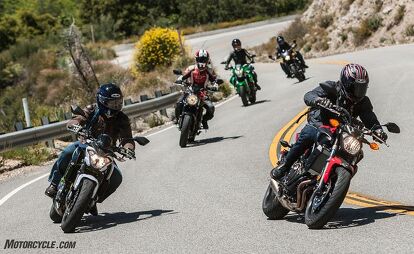











































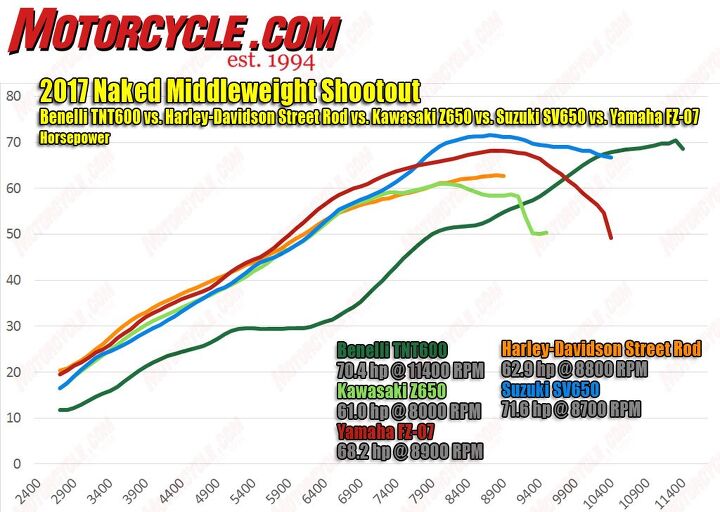





























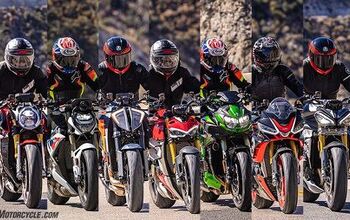
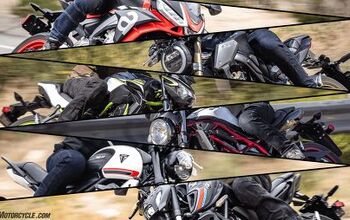

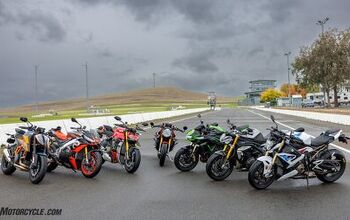










Comments
Join the conversation
Sometimes I wonder if the manufacturers have cut back in the design department on an agreed upon basis.None look desireable.
My baby girls is Benelli Tnt 600 https://motorhaberleri.com/...